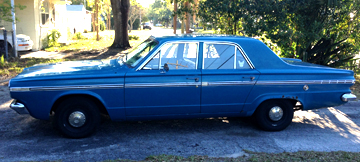When I was in my twenties I went through one of my car-less periods, only a motorcycle for basic transport. Rain or shine, winter or summer, I rode. Jerry, a guy I knew, felt bad for me one wintry day. He gave me a car.

It was an old Dodge Dart. I don’t recall the year. If you’re anywhere near my age you’ve probably seen thousands upon thousands of these old Dodge Darts on the road. They were bulletproof: slant-six engine; three-speed on the column; torsion-bar suspension; bench seats complete with the saggy back rest. This one was blue. The interior was all musty from sitting in Jerry’s mom’s backyard for months and months. (She may have pressured him to get it out of there, helping lead to my good fortune.)
I remember when Jerry bought the Dodge. He wasn’t much of a mechanic and he had asked for my help with its assessment. “The clutch is slipping some,  you’ll need to replace it eventually. But otherwise it’s reasonable.†I think he paid a couple hundred for it.
When I got my hands on that old Dodge the clutch was still slipping some. The engine had two operating temperatures: hotter than hell, and hotter than hotter than hell. Coolant boiled out regularly; the water jugs in the backseat were a permanent fixture. But that ol’ engine never faltered, not once. In fact, it always delivered excellent heat. And judging by the sludge in the crankcase I don’t think Jerry ever got around to changing the oil in the couple of years he had it. I know I didn’t.
I used to have fun with that slippery clutch! I knew a new friction plate would be cheap and easy to install. It became something of a game to see how much abuse the poor little clutch could take. I’d wind that little engine for all it was worth and sidestep the pedal just to catch a whiff of the burning plate.
I was using that very technique to enter the highway, pulling out of a local titty bar one afternoon, when the clutch signalled it had finally had just about enough. The sound was odd and clunky – not good at all. A bit of friction remained, though, and the car lurched ahead. I didn’t dare touch the pedal during the short ride home.
The decision had been a sound one. The very next pedal depression was its last. Oh, the pedal would move alright, but it no longer mattered. Engine on or off, pedal or not, any gear could be selected at will while the car no longer moved on its own.
So the next weekend I picked up a friction plate, release bearing, and other assorted parts and set to work. The drivetrain and transmission came out easy enough. But what remained of that poor clutch was a sight to behold. Some dust and shredded friction material along with some broken metal fell out of the housing to the asphalt. It was one of those moments that fairly begged for a digital camera. But this was WAY before that technology became ubiquitous. In short order the new clutch was again transferring engine power to the transmission!
I was working in Bridgeport, Connecticut at the time and Monday morning I set out from my New Jersey home with confidence. With a week’s worth of clothing (and several water jugs) in the backseat, all was well with the world and the ride up Route 95 went without incident. But as I reached the job site there was a mighty clunk from the front end as the left front quarter sagged nearly to the ground. A quick look confirmed my suspicion: the torsion bar had broken free, its mount in the frame rusted out.
At the end of the day, before I checked into my hotel, I found a salvage yard and limped the old Dodge to its final resting place.
The yard operator paid me just about enough to cover my clutch parts.






Great story. My friend had an old dart and we would our vehicles at each other and veer off at the last second. One time I did it and found an old lady behind the wheel of the same color car. She was quite shocked.